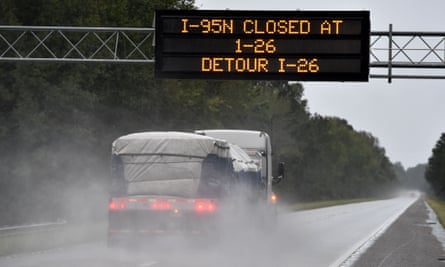Scientists say climate change has exacerbated the effects of a storm blamed for at least 12 deaths in the south-eastern US.
On Monday, after weekend downpours, flooding continued to overwhelm large parts of South Carolina and North Carolina in what was described as a “once-in-a-millennium” storm.
Individual weather events cannot be attributed to climate change, but climatologists say atmospheric conditions tied to climate change intensified this downpour.
“This is yet another example, like Sandy or Irene, of weather on ‘steroids’, another case where climate change worsened the effects of an already extreme meteorological event,” said Michael Mann, director of the Earth System Science Center at Pennsylvania State University.
Mann said hurricane Joaquin intensified in the tropical Atlantic, which is experiencing record sea-surface temperatures. These temperatures helped the hurricane strengthen quickly and unusually warm, wet air fed it even more. That moisture turned into the record rainfall which fell on the Carolinas.
“In this case, we’re seeing once-in-a-thousand year flooding along the South Carolina coastline as a consequence of the extreme supply of moisture streaming in from hurricane Joaquin,” Mann said.
The “once-in-a-thousand” phrase does not mean the storm occurs once every 1,000 years, but rather that there is a 0.1% chance of such an intense storm occurring in any year.

After a week of steady rain, thousands of South Carolina residents faced the prospect of going days without running water, and daily life was disrupted by dams overflowing, bridges collapsing and hundreds of roads inundated by floodwaters .
“This is a Hugo-level event,” major general Robert Livingston, head of the South Carolina National Guard, said on Monday, referring to the September 1989 hurricane that devastated Charleston. “We didn’t see this level of erosion in Hugo. ... This water doesn’t fool around.”
At least 10 people have died in South Carolina and two in North Carolina, with about 1,000 forced into shelters. About 40,000 have been left without drinkable water.
South Carolina’s governor, Nikki Haley, on Sunday told people to stay inside their homes for safety. The government closed 381 roads, including major interstates and 127 bridges.
Trees standing on saturated land toppled in high winds. One person was killed when a tree hit a car in North Carolina. A woman died after her car was swept away.
Dennis Feltgen, a meteorologist and spokesman for the National Oceanic and Atmospheric Administration’s National Hurricane Center, said in an email that “no single weather event can be attributed to climate change”.

But government-backed reports show that climate change can exacerbate the severity of storms. The 2009 National Climate Assessment said that by mid-century some parts of the US could experience two or more days of rainfall per year that exceed local records.
This is happening in parts of South Carolina. The National Weather Service said that it was the wettest day in the history of Columbia, the state capital.
On Monday Kristin Dow, a geography professor at the University of South Carolina, was stuck inside her Columbia home. She said nearby neighborhoods had been inundated, washing away buildings and making shopping centers look like lakes.
Dow assesses the impacts and probability of climate change and has edited government reports on the risks climate change presents to the south-east.
“It’s one thing to know there is a one in a thousand year chance but it’s another thing to imagine what it would look like on the ground,” she said.
The latest death caused by the floods, according to the Associated Press, occurred on Sunday night when a car drove into a barricade near Columbia and stalled. The driver drowned; a firefighter was able to rescue a passenger who climbed on top of the car.
“She came out the window,” said the Kershaw County coroner, David West. “How she got on top of the car and stayed there like she did with that water – there’s a good Lord.”
Comments (…)
Sign in or create your Guardian account to join the discussion